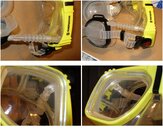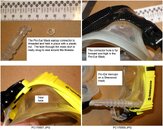gert7to3
Contributor
- Messages
- 1,167
- Reaction score
- 120
- # of dives
- 200 - 499
Ok sportsfans, here's a DIY project to transplant the earcups from a Pro-Ear mask to the mask of your choice.
Problem 1: The Pro-Ear mask is a low volume mask with a limited field of view.
Problem 2: You already have a mask you really like, perhaps a prescription mask, but
want the advantages of dry ears.
I originally thought that the Pro-Ear mask had the earcup hoses molded into the mask skirt. Close examination showed they were bolted in. The mask skirt simply had very small holes punched through it for the earcup hose connectors. These were attached with hex-nuts on the inside of the mask skirt.
A few caveats. This will totally void your mask warranty. I used a hole punch to cut the holes through the mask skirt. A drill probably won't work. However, a piece of 1/8" brass tubing could be sharpened and used to cut the holes in the mask skirt. These holes must be small so the mask skirt fits tightly around the threaded connector tube. The connectors must located very far forward. Otherwise they may concact your face underwater.
Some pictures follow. I haven't gotten this wet yet. My spousal unit might not accept the excuse of "product testing", to justify a third trip to Bonaire in less than a year.
Problem 1: The Pro-Ear mask is a low volume mask with a limited field of view.
Problem 2: You already have a mask you really like, perhaps a prescription mask, but
want the advantages of dry ears.
I originally thought that the Pro-Ear mask had the earcup hoses molded into the mask skirt. Close examination showed they were bolted in. The mask skirt simply had very small holes punched through it for the earcup hose connectors. These were attached with hex-nuts on the inside of the mask skirt.
A few caveats. This will totally void your mask warranty. I used a hole punch to cut the holes through the mask skirt. A drill probably won't work. However, a piece of 1/8" brass tubing could be sharpened and used to cut the holes in the mask skirt. These holes must be small so the mask skirt fits tightly around the threaded connector tube. The connectors must located very far forward. Otherwise they may concact your face underwater.
Some pictures follow. I haven't gotten this wet yet. My spousal unit might not accept the excuse of "product testing", to justify a third trip to Bonaire in less than a year.






